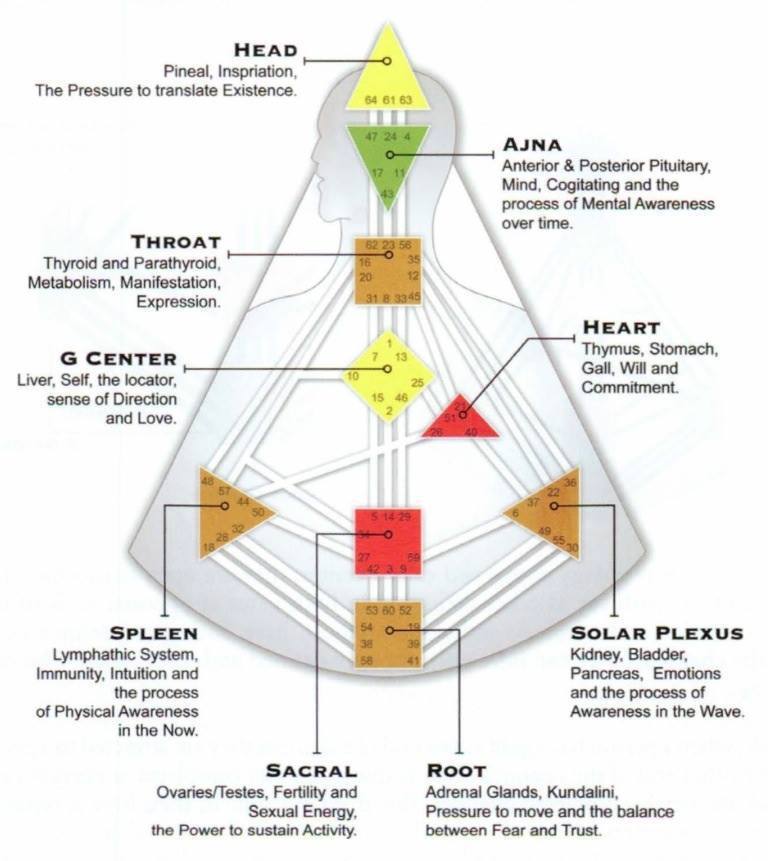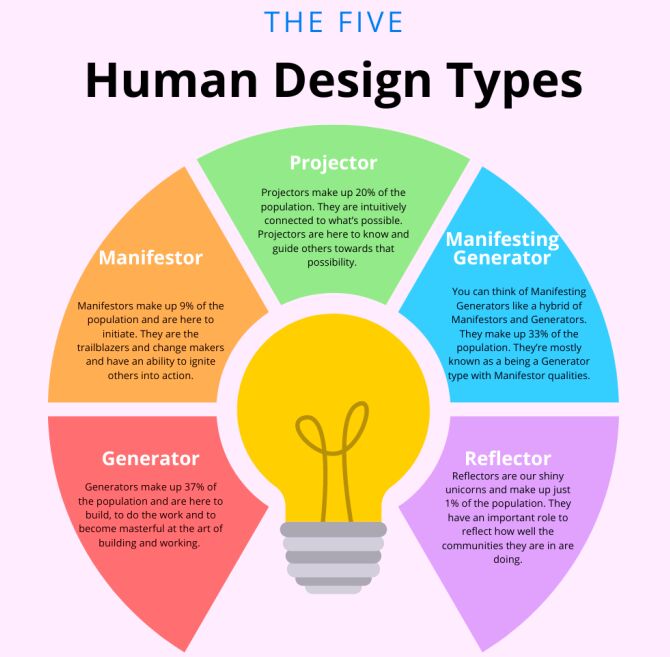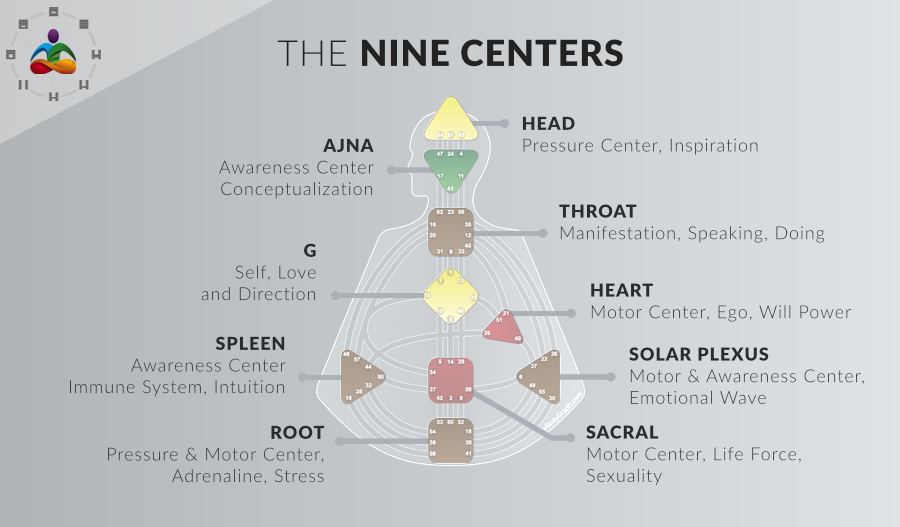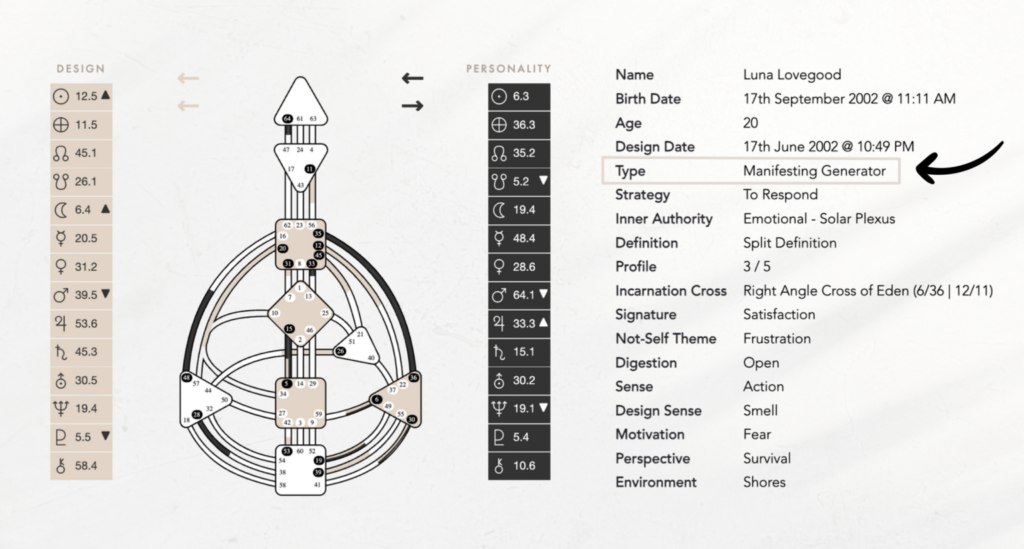Have you ever wondered why you make certain decisions, excel in particular areas, or struggle with specific challenges? The answer could lie within your unique human design.
Personally, I just recently stumbled upon this system and learned that I am a Generator Energy type. And boy, did that explain a lot to me.
I’m still reading up on my design, so join me as we delve into the fascinating realm of Human Design.
Let’s explore how understanding this system can bring clarity and empowerment to our lives.
Whether you’re embarking on a personal growth journey, seeking self-discovery, or looking to improve your relationships, I believe Human Design can provide profound insights.
Together, we’ll try to unlock the mysteries of Human Design and unleash the potential that lies dormant within you (and me!). Unveil your inner blueprint and move closer towards a life of alignment, fulfilment, and purpose
What is Human Design

By integrating astrology, the I Ching, the Kabbalah, and the chakras,
Human Design offers a comprehensive perspective on who you are and how you interact with the world by integrating:
It’s a great way to discover your inherent strengths, your decision-making strategy, and your energetic tendencies, all based on the specific alignment of celestial bodies at the moment of your birth.
Essentially, Human Design is a revolutionary system that combines several ancient wisdom traditions to give individuals a deep understanding of themselves.
It was founded by Ra Uru Hu, who received a mystical revelation in 1987 that led to the development of this unique system. Human Design integrates astrology, the I Ching, the Kabbalah, and the chakras to create a comprehensive framework for self-discovery and personal growth.
The history and origins of Human Design
To truly appreciate the power of Human Design, it’s important to understand its origins.
Ra Uru Hu, the founder of Human Design, claimed to have received a mystical revelation while living on the island of Ibiza in 1987. This revelation provided him with the knowledge and insights to develop the Human Design system.
Ra Uru Hu spent the next 25 years refining and sharing his teachings, conducting thousands of individual readings and workshops around the world.
Today, Human Design has gained a significant following and continues to provide individuals with valuable insights into their true nature and life purpose.
The five types in Human Design

In Human Design, there are five energy types, each with its own unique characteristics and strategies for living a fulfilling life.
Understanding your energy type can provide valuable insights into how you interact with the world and make decisions.
Generators
Generators are the most common energy type, representing around 70% of the population. They have a sustainable and consistent energy that can be harnessed to bring fulfilment and satisfaction in life.
Manifestors
Manifestors have a powerful and independent energy that allows them to initiate and create change. They are here to impact and influence the world around them.
Projectors
Projectors have a focused and penetrating energy that allows them to guide and direct others. They have a natural talent for seeing people’s potential and offering guidance.
Reflectors
Reflectors have a unique and sensitive energy that allows them to deeply reflect the state of the world around them. They are like mirrors, reflecting the health and well-being of their communities.
Manifesting Generators
Manifesting Generators have a combination of the Generator and Manifestor energy types. They are here to move quickly and efficiently, manifesting their desires with their powerful energy.
Understanding your energy type can help you align with your unique strengths and live a life that feels authentic and fulfilling.
Understanding the different centers in Human Design

Human Design recognises nine energy centres in the body, each representing different aspects of our personality and life experiences.
These centres are like energetic hubs that influence our behaviours, emotions, and decision-making processes.
Head Center
The Head Center represents our mental processes, thoughts, and ideas. It’s where inspiration and insights originate.
Ajna Center
The Ajna Center governs our intellect, logic, and analysis. It helps us make sense of the information we receive.
Throat Center
The Throat Center is the centre of communication, self-expression, and manifestation. It governs our ability to share our thoughts and ideas with the world.
G Center
Also known as the Center of Identity, the G Center represents our sense of self and direction in life. It helps us find our purpose and navigate our journey.
Heart Center
The Heart Center is the centre of love, willpower, and self-esteem. It governs our ability to follow our heart’s desires and make decisions from a place of authenticity.
Sacral Center
The Sacral Center is the centre of life force energy and vitality. It governs our ability to work, create, and experience pleasure.
Spleen Center
The Spleen Center represents our intuition, instincts, and survival instincts. It helps us make decisions based on our gut feelings.
Solar Plexus Center
The Solar Plexus Center governs our emotions and emotional intelligence. It influences our moods, sensitivity, and empathy.
Root Center
The Root Center represents our drive, ambition, and sense of urgency. It governs our ability to take action and handle stress.
Understanding the energy dynamics of these centres can provide profound insights into our behavioural patterns, strengths, and challenges.
How to read a Human Design chart

Reading a Human Design chart may seem complex at first, but with a little guidance, it becomes a powerful tool for self-discovery.
A Human Design chart is a visual representation of your unique energetic blueprint, based on the alignment of celestial bodies at the moment of your birth.
The chart consists of various shapes, lines, and numbers, each representing different aspects of your design.
The centres, as mentioned earlier, are represented by geometric shapes, while the lines and numbers provide more specific information about each centre’s energy.
To read your Human Design chart, start by understanding your energy type and centre configuration. Then, explore the different gates and channels in your chart, which represent specific aspects of your personality and life experiences.
Finally, consider any defined or undefined centres and how they influence your energy and decision-making processes.
The role of astrology in Human Design
Astrology plays a significant role in Human Design.
The alignment of celestial bodies at the moment of your birth provides the foundation for your unique design. Human Design incorporates key astrological principles, such as the positioning of the planets, to determine the characteristics and tendencies associated with each energy type and centre.
By understanding the astrological influences in your Human Design chart, you can gain deeper insights into your personality, life purpose, and potential challenges.
Astrology adds another layer of richness to the already complex and intricate system of Human Design.
Using Human Design for self-discovery and personal growth

Human Design is not just another personality typing system.
It goes deeper, tapping into the energy that flows within us and the universe. By understanding your unique design, you can gain valuable insights into your strengths, weaknesses, and areas for growth.
One of the core elements of Human Design is the identification of your Energy Type. There are five types: Manifestor, Generator, Manifesting Generator, Projector, and Reflector.
Each type has its own unique way of interacting with the world and harnessing its energy.
For instance, Generators like myself are designed to respond to life and follow our gut feelings.
Understanding this aspect of my design has allowed me to make decisions that are more aligned with my true self, leading to greater fulfilment and satisfaction.
In addition to Energy Type, Human Design also provides insights into decision-making strategies.
The strategy for each type is based on the concept of waiting for clarity or recognition before taking action.
For Generators, this means waiting for a gut response or a feeling of excitement before committing to something. By following this strategy, we can avoid wasting our energy on things that don’t resonate with us and instead focus on opportunities that truly align with our purpose.
Another fascinating aspect of Human Design is the analysis of our energetic centres, known as chakras.
These centres represent different aspects of our being, such as communication, intuition, and manifestation. By understanding which centres are defined or open in our design, we can gain insights into our natural strengths and areas for growth.
For example, if you have a defined throat centre, you may have a natural gift for communication and expression.
On the other hand, if your throat centre is open, you may have a tendency to absorb the communication styles of others. Recognising this can help you develop healthier communication patterns and find your authentic voice.
In summary, using Human Design for self-discovery and personal growth allows us to uncover our unique strengths, make decisions that align with our true selves, and understand how we interact with the world around us.
It provides a roadmap for personal development and empowers us to live a more authentic and fulfilling life.
Applying Human Design in relationships and communication

Human Design not only provides insights into our individual designs but also offers valuable tools for improving our relationships and communication with others.
One of the key aspects of Human Design is understanding our energetic interaction with others. By analyzing the compatibility of our designs, we can gain insights into the dynamics of our relationships and how to navigate them more effectively.
For example, if you’re in a relationship with a Projector, who is designed to guide and direct others, it’s important to recognise their need for recognition and invitation before offering advice or assistance. Understanding this aspect of their design can lead to more harmonious interactions and deeper connections.
In addition to compatibility, Human Design also offers valuable insights into our communication styles.
Each type has its own unique approach to communication, and understanding these differences can help us communicate more effectively with others.
For example, Manifestors tend to be direct and assertive in their communication, while Projectors excel at asking powerful questions and guiding conversations.
By recognising and appreciating these differences, we can foster better understanding and collaboration in our relationships.
Furthermore, Human Design offers insights into how we can best support and nurture others based on their design.
For example, as a Generator, I thrive when I’m given autonomy and the freedom to respond to life. Recognizing this, my partner has learned to provide me with space and opportunities to follow my gut instincts, which has greatly enhanced our relationship.
Similarly, understanding the needs of others based on their design can help us create more supportive and fulfilling relationships.
Ultimately, applying Human Design in relationships and communication allows us to navigate the dynamics of our connections more effectively, foster deeper understanding and collaboration, and create more supportive and fulfilling relationships.
Integrating Human Design into everyday life

Understanding Human Design is not just a one-time endeavour.
It’s a lifelong journey of self-discovery and growth. To truly harness the power of Human Design, it’s important to integrate its principles into our everyday lives.
One way to integrate Human Design into our lives is by using it as a guide for decision-making.
By following our unique decision-making strategy, based on our Energy Type, we can ensure that we’re making choices that align with our true selves.
For example, as a Generator, I’ve learned to wait for my gut response before committing to projects or opportunities. This has allowed me to avoid burnout and pursue endeavours that truly resonate with me.
Another way to integrate Human Design into our lives is by recognizing and honouring our energetic needs. Each type has its own unique energetic tendencies, and understanding these can help us create a more supportive and balanced lifestyle.
As for me, as a Generator, I thrive when I have consistent physical activity and a sense of purpose in my endeavours. By incorporating these elements into my daily routine, I can maintain a higher level of energy and fulfilment — even deal with those Monday blues (most of the time, anyways!).
Furthermore, integrating Human Design into our lives means embracing our unique blueprint and living authentically. Human Design reminds us that we are not meant to fit into societal moulds or conform to others’ expectations.
Instead, we are here to express our true selves and follow our own path. By embracing our unique design, we can unlock our full potential and live a life of alignment, fulfilment, and purpose.
In summary, integrating Human Design into our everyday lives allows us to make choices that align with our true selves, honour our energetic needs, and live authentically.
Time to embrace your unique blueprint

Human Design is a powerful system that unveils the blueprint of our true selves.
By understanding our unique design, we can gain profound insights into our strengths, decision-making strategies, and energetic tendencies. Whether we’re seeking self-discovery, personal growth, or improved relationships, Human Design offers valuable tools and perspectives.
As I continue to explore my own Human Design, I am amazed at the clarity and empowerment it brings to my life.
It’s a journey of self-discovery and growth that never ends.
So, I invite you to delve into the fascinating realm of Human Design, unlock the mysteries of your inner blueprint, and move closer towards a life of alignment, fulfilment, and purpose.
Let’s embrace our unique designs and unleash the potential that lies dormant within us. Welcome to the world of Human Design!






No Comment